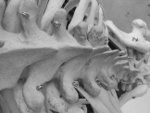 A multicenter retrospective review of pediatric patients who underwent spinal instrumentation to correct scoliosis published in the Journal of Bone & Joint Surgery examined the surgical site infection rate for different etiologies.
A multicenter retrospective review of pediatric patients who underwent spinal instrumentation to correct scoliosis published in the Journal of Bone & Joint Surgery examined the surgical site infection rate for different etiologies. Here are eight statistics on the findings:
1. 9.2 percent of patients who underwent surgery for neuromuscular scoliosis reported surgical site infections, the highest reported in this study.
2. 8.8 percent of patients who underwent surgery with syndromic scoliosis reported surgical site infections.
3. 3.9 percent of patients undergoing surgery for congenital scoliosis reported surgical site infections.
4. 2.6 percent of patients with idiopathic scoliosis reported surgical site infections postoperatively.
5. Among patients with other types of scoliosis, 8.8 percent reported surgical site infections.
6. Risk factors for surgical site infections were non-idiopathic scoliosis — 97 percent of the surgical site infections were in patients with non-idiopathic scoliosis — and extending instrumentation to the pelvis.
7. 25 percent of the patients who contracted surgical site infections reported Staphylococcus aureus.
8. 46.5 percent of patients with surgical site infections contained at least one gram-negative organism.
Surgeon authors listed on the study include Jacqueline Corona, MD, of the division of orthopedic surgery at Southern Illinois University School of Medicine; Christopher Lee, MD, of the division of orthopedic surgery at Children's Hospital Los Angeles; John M. Flynn, MD, and David L. Skaggs, MD, of the department of orthopedic surgery at The Children's Hospital of Philadelphia; David P. Roye, MD, and Michael G. Vitale, MD, of the division of pediatric orthopedic surgery in the department of orthopedic surgery at Columbia University Medical Center in New York City.
More Articles on Spine Surgery:
Combining a Drive for Medicine & Sports: Q&A With Dr. Hooman Melamed of DISC Sports & Spine
9 Recent Spine Surgeon Honors
Neurosurgeon Annual & Hourly Pay: 8 Statistics


